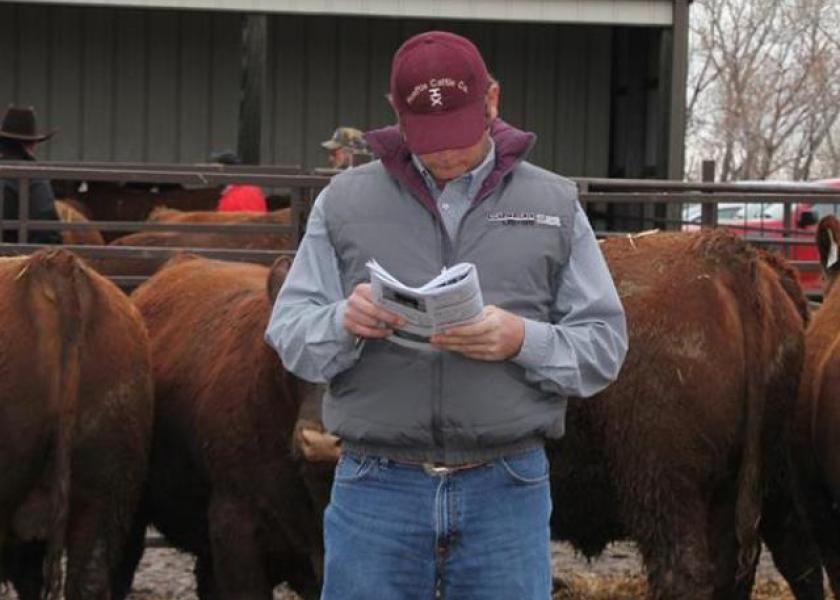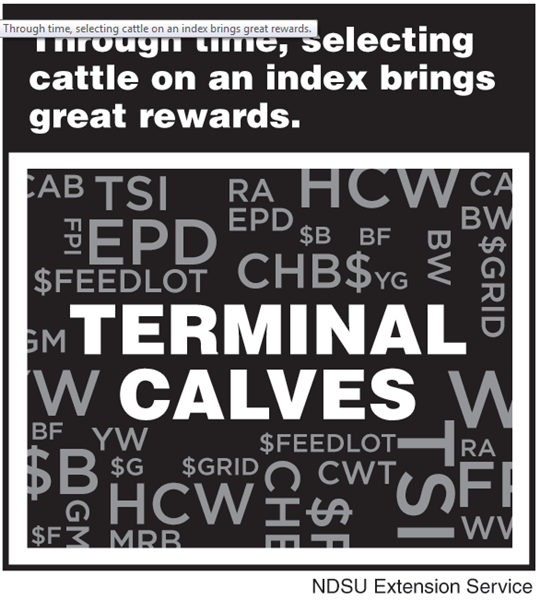BeefTalk: Terminal Breed Indexes Available at Your Breed Association Website

Selection indexes can help producers buy bulls destined to sire terminal calves.
By: Kris Ringwall, Beef Specialist, NDSU Extension Service
The objective for beef cows is to produce a calf.
About 15 to 20 percent of the calves are destined as replacements, so the remaining 80 to 85 percent of the calves go the feed yard as terminal cattle. Given that fact, breed associations have developed selection indexes that help producers select bulls destined to sire terminal calves.
Selection indexes correlate production and financial outcomes by combining performance records with economic weights. They are reported as dollar values to indicate the amount of profit or savings the producer could expect when utilizing that index. This sounds complicated, but indexes do work.
The following terminal index definitions are from the respective breed association websites (with some edits):
- The American International Charolais Association produces a Terminal Sire Index (TSI). The TSI combines U.S. Department of Agriculture economic data with the expected progeny differences (EPD) for growth (birth weight, weaning weight and yearling weight) and carcass traits (rib-eye area, hot carcass weight, marbling and back fat) into one single EPD value. This EPD value represents a dollar index and is used like single-trait EPD values.
- The American Hereford Association Certified Hereford Beef Index (CHB$) is a terminal sire index in which Hereford bulls are used on British-cross cows. All offspring are sold as fed cattle on a CHB pricing grid. This index places no emphasis on milk or fertility because all cattle will be terminal. This index promotes growth and carcass.
- The American Gelbvieh Association Feeder Profit Index (FPI) is an economic selection index designed to aid producers in selecting sires whose progeny will perform in the feedlot and are sold on grade and yield. Well-ranking sires for FPI have higher marbling and carcass weight than their contemporaries.
- The American Angus Association Beef Value ($B) index is expressed in dollars per head and is the expected average difference in future progeny performance for postweaning and carcass value, compared with progeny of other sires.
- The American Angus Association also produces two additional indexes: $Feedlot and $Grid. The $Feedlot Value ($F), expressed in dollars per head, is the expected average difference in future progeny performance for postweaning merit, compared with progeny of other sires. The $F incorporates weaning weight and yearling weight EPDs, along with feed intake data, genomic information and trait interrelationships. Typical feedlot gain value and cost differences are accounted for in the final calculations, along with a standard set of industry values for days on feed, ration costs and cash cattle price.
- The Red Angus Association of America’s GridMaster Index (GM) is built using Red Angus bulls mated to cows, and all progeny are sold on a quality-based carcass grid. The GridMaster Index goal is to maximize profitability of feeders in the feed yard and on the rail.
- The American Simmental Association Terminal Index (TI) evaluates sires for use on mature Angus cows, with all offspring put on feed and sold on grade and yield.
In closing, I would like to come back to the Grid Value index for the American Angus Association. Read the definition of the Grid Value index slowly and carefully and ask yourself, “How would one actually utilize all the data variables mentioned without an index?”
The Grid Value ($G) is expressed in dollars per head and is the expected average difference in future progeny performance for carcass grid merit, compared with progeny of other sires. The $G combines quality grade and yield grade attributes and is calculated for animals with carcass EPDs.
A three-year rolling average is used to establish typical industry economic values for quality grade and yield grade schedules. Quality grade premiums are specified for Prime, CAB and Choice carcasses, as well as Select and Standard discounts. Yield grade premiums are incorporated for YG 1 and YG 2 (high-yielding carcasses), with discounts for YG 4 and YG 5 (low red meat yields). Grid impact in dollars per hundredweight and dollars per head is calculated from the yield and quality grade components, then combined to arrive at the $G.
Wow, that is a lot of information and, thus, the value of an index. Perhaps some might feel the utilization of index EPDs actually makes sire selection too easy. The truth is, selecting cattle on an index, through time, works. The bottom line: Individual producers must establish goals and objectives. Once developed, indexes are a great tool to accomplish those goals.
May you find all your ear tags.








